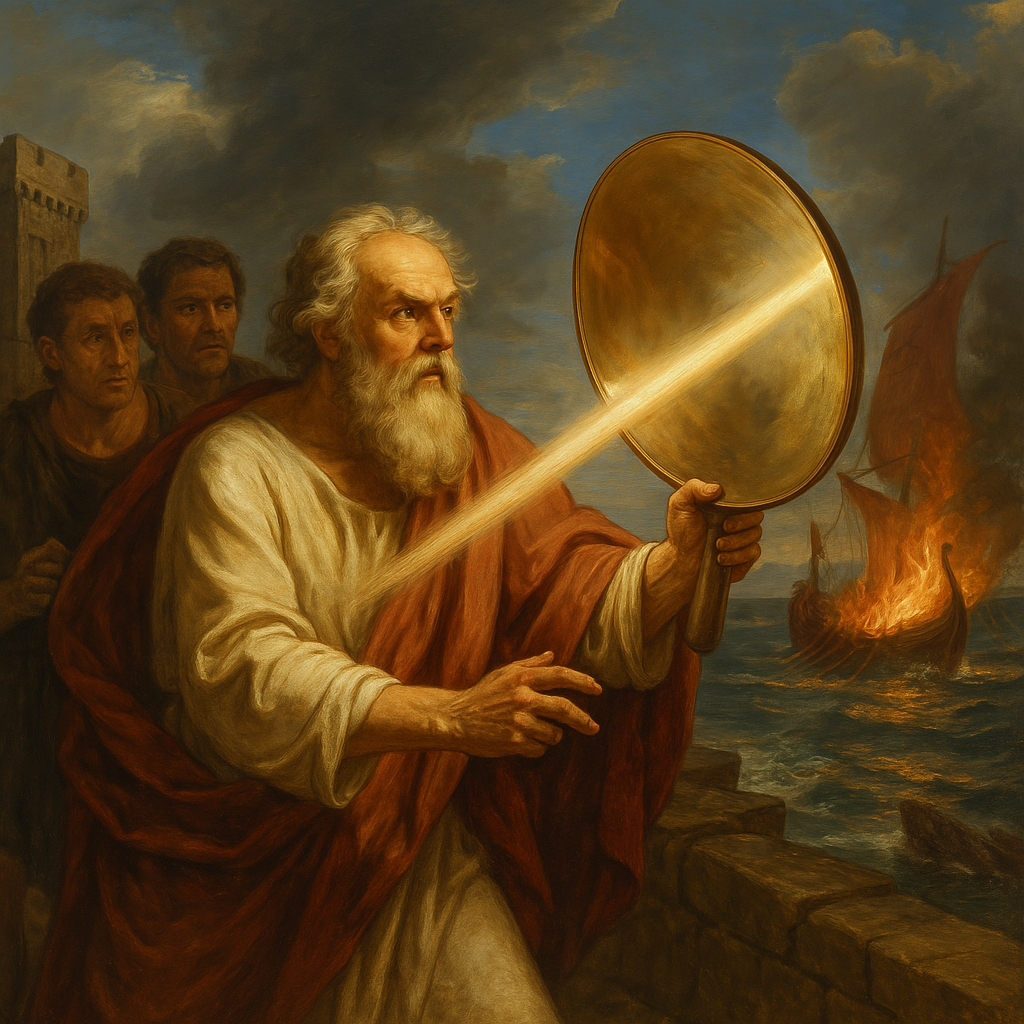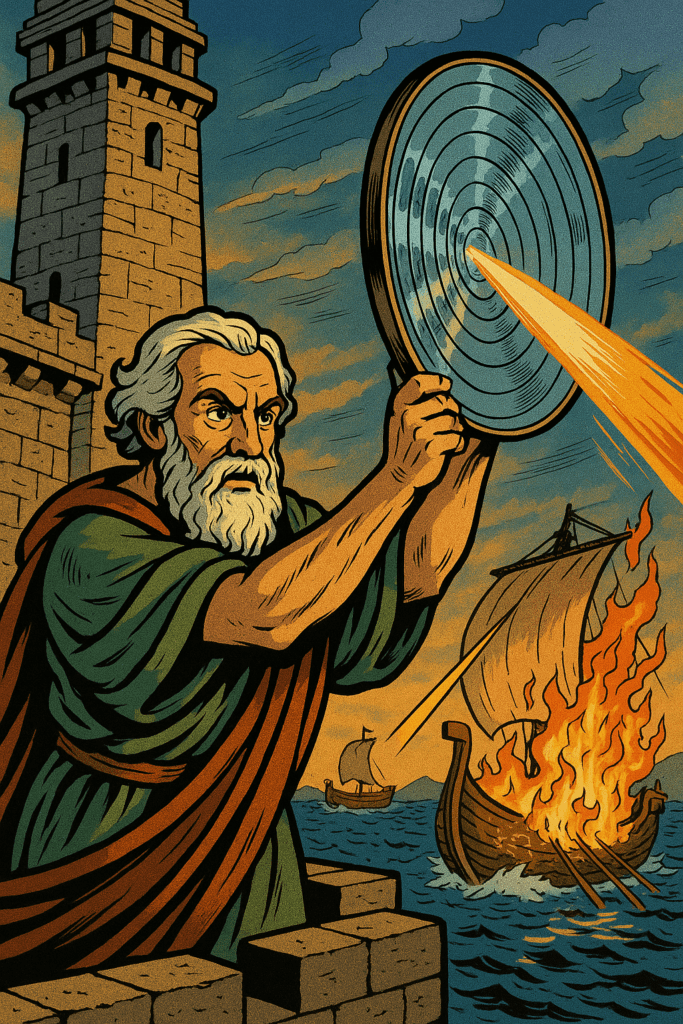Ancient DEW known as Burning Mirrors
The concept of DEWs has ancient roots, such as the legendary use of burning mirrors by Archimedes to set Roman ships ablaze during the Siege of Syracuse.
The Burning Mirror Legend: Archimedes, Ancient Beams, and the Forgotten Fire from the Sky
The Siege of Syracuse in 212 BCE is remembered not only for its brutal Roman conquest but for a legend that has refused to die: Archimedes and the burning mirrors. As the Roman fleet closed in on the city walls, the Greek polymath was said to have devised a weapon so strange it bordered on the miraculous—an array of polished mirrors that focused sunlight to ignite enemy ships. While many historians dismiss this story as myth, the deeper history of concentrated solar weapons and directed energy in antiquity suggests there may be more than firelight behind the tale.
Archimedes’ Burning Mirror: Myth or Memory?
The earliest account of Archimedes using mirrors as weapons comes centuries after the siege. Lucian of Samosata, writing in the 2nd century AD, describes how mirrors concentrated solar rays onto ships. Later Byzantine writers such as Anthemius of Tralles elaborated on the technique, suggesting a curved parabolic array of polished bronze mirrors.
In modern times, this concept has been repeatedly tested. In 1973, a Greek scientist, Ioannis Sakkas, used 70 mirror panels to set a wooden boat aflame from 160 feet away. The test was successful under ideal conditions. Yet, the logistical difficulty of aligning a massive mirror array to ignite moving ships has cast doubt on its battlefield utility. But perhaps this isn’t about logistics. Perhaps it’s about forgotten technologies.
Fresnel Lenses: A Modern Relic of Ancient Methods
The principle behind burning mirrors is simple: focus radiant energy into a point. This principle is exemplified in the Fresnel lens, a flat, concentric ring design that mimics the focusing ability of a much thicker convex lens. Invented by Augustin-Jean Fresnel in the 19th century for use in lighthouses, these lenses could cast light for miles.
Yet curiously, most modern lighthouses no longer employ Fresnel lenses. Many have been removed or decommissioned, citing cost or maintenance issues. But could there be another reason? A Fresnel lens, when turned sunward, becomes a powerful beam weapon. Was the lighthouse, in some original form, not only a beacon but a defensive weapon—a sun-powered deterrent to enemy vessels?

Lighthouses as Defensive Energy Weapons
Several ancient coastal structures, from the Pharos of Alexandria to Roman and Phoenician towers, appear to have served more than just navigational functions. The Pharos in particular was described as having mirrors at its apex to reflect sunlight by day and firelight by night. Ancient records imply that the reflected beam could be seen dozens of miles away—but what if it could do more than just signal?
Reconstructing ancient technologies, including rotating lenses or mirror arrays, suggests the possibility that these lighthouses were dual-purpose: guiding allies, burning foes. It is no stretch to imagine mirrored weaponry hidden in high towers, concealed beneath a veil of maritime aid.
Molten Stone, Glass, and Evidence of Energy Weapons in Antiquity
There are ancient sites with perplexing features that imply exposure to intense heat. In Egypt, vitrified stone and sand-turned-glass at sites such as Saqqara or parts of the Giza Plateau raise questions. Natural lightning? Meteor strikes? Or artificially directed energy?
Even older, the mysterious ruins at Mohenjo-Daro in the Indus Valley exhibit signs of sudden, extreme heating, with walls fused and bodies left in lifelike poses, as if some intense force struck suddenly. Ancient Sodom and Gomorrah were said to have been consumed by fire from the sky.
Desert glass found in Libya and in parts of South America shares the same composition as nuclear-test fused sands, yet no craters or natural sources exist nearby. Might focused solar arrays or high-energy weapons have been used by advanced civilizations predating our known history?
Airborne Burners: Airships and the Sky-Dominion Theory
The idea of ancient airships sounds fanciful—until one reviews art, texts, and carvings from ancient Egypt, China, and Mesoamerica. The Dendera reliefs of Egypt, the Vimanas of India, the flying shields of Rome—all speak to sky-faring technologies.
Could fleets of solar-powered airships have once patrolled the skies, equipped with mirrors or Fresnel-like lenses? High-altitude burning arrays would have had a tactical advantage: mobility, line-of-sight targeting, and magnified solar intensity. Imagine the psychological impact of fire raining down from the heavens.
And who controlled these fleets? Some trace the roots of organized aerial domination to priestly castes, technocratic orders cloaked in religion. The Jesuits, or their precursors, are often implicated in arcane knowledge transmission, astronomy, and the engineering of megalithic cathedrals that resemble focused energy temples. The same entities who once cast the light may now obscure it.
Conclusion: Sunfire Remembered
Whether Archimedes ignited Roman ships with mirrors or not, the broader tradition of solar weaponry and focused energy beams is deeply rooted in the ancient world. From burned ships to vitrified temples, from glass in deserts to mirrored towers, the evidence whispers of a forgotten mastery of the sun’s power.
The real question is not whether Archimedes used burning mirrors. The real question is: Who else did?
Sources:
- Lucian of Samosata, Icaromenippus, 2nd century AD
- Anthemius of Tralles, On Burning Mirrors, 6th century AD
- Sakkas, Ioannis. “Experiments with Archimedes Mirrors,” 1973 Athens Naval Test
- Fresnel, Augustin-Jean, “Memoir on Lighthouses,” 1822
- Hancock, Graham. Fingerprints of the Gods. 1995.
- Joseph, Frank. The Lost Civilization of Lemuria. 2006.
- Churchward, James. The Lost Continent of Mu. 1926.
- Vitruvius, De Architectura, Book IX
- Dendera Temple Complex Reliefs, Egypt
- Childress, David Hatcher. Technology of the Gods. 2000

